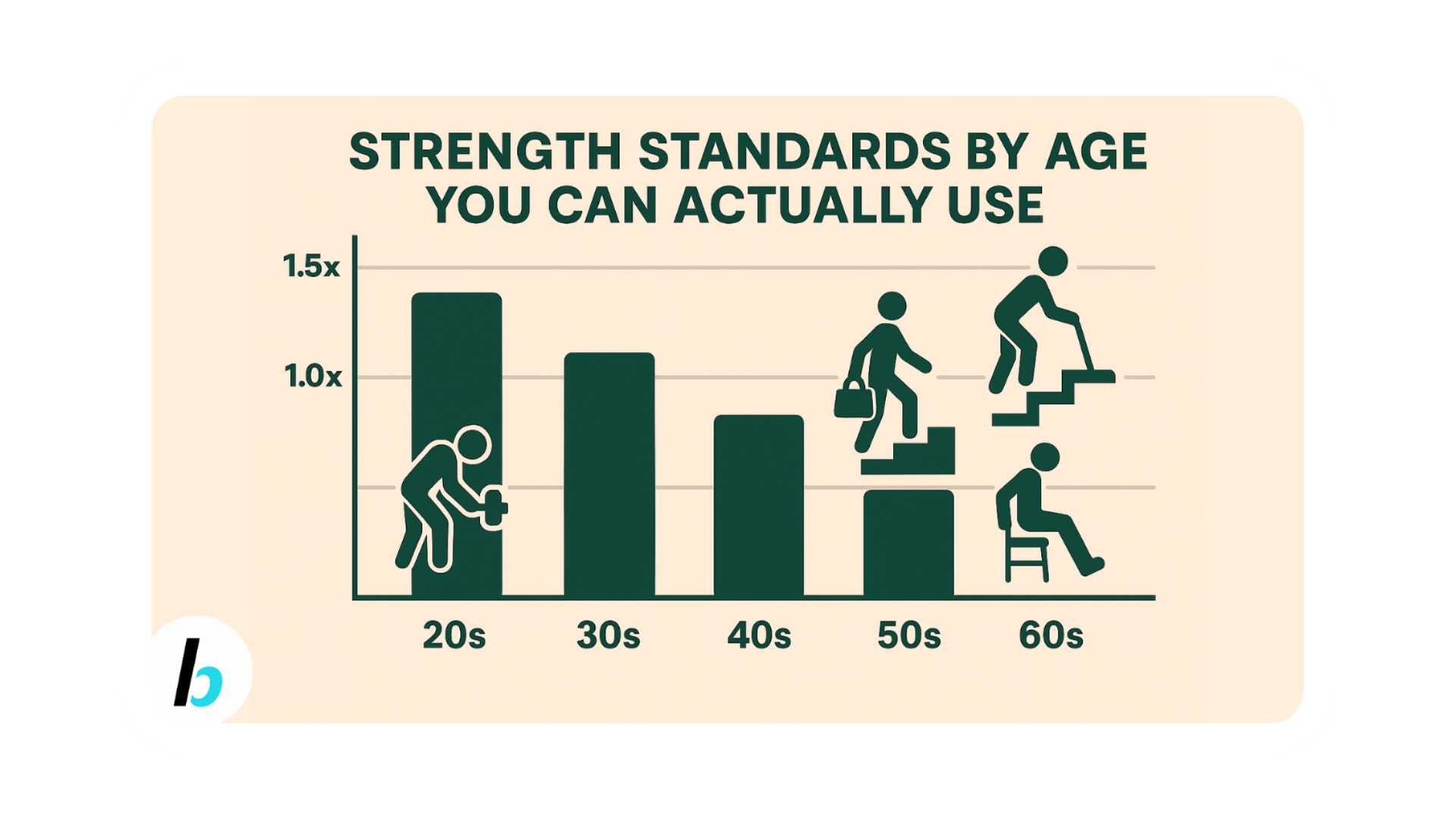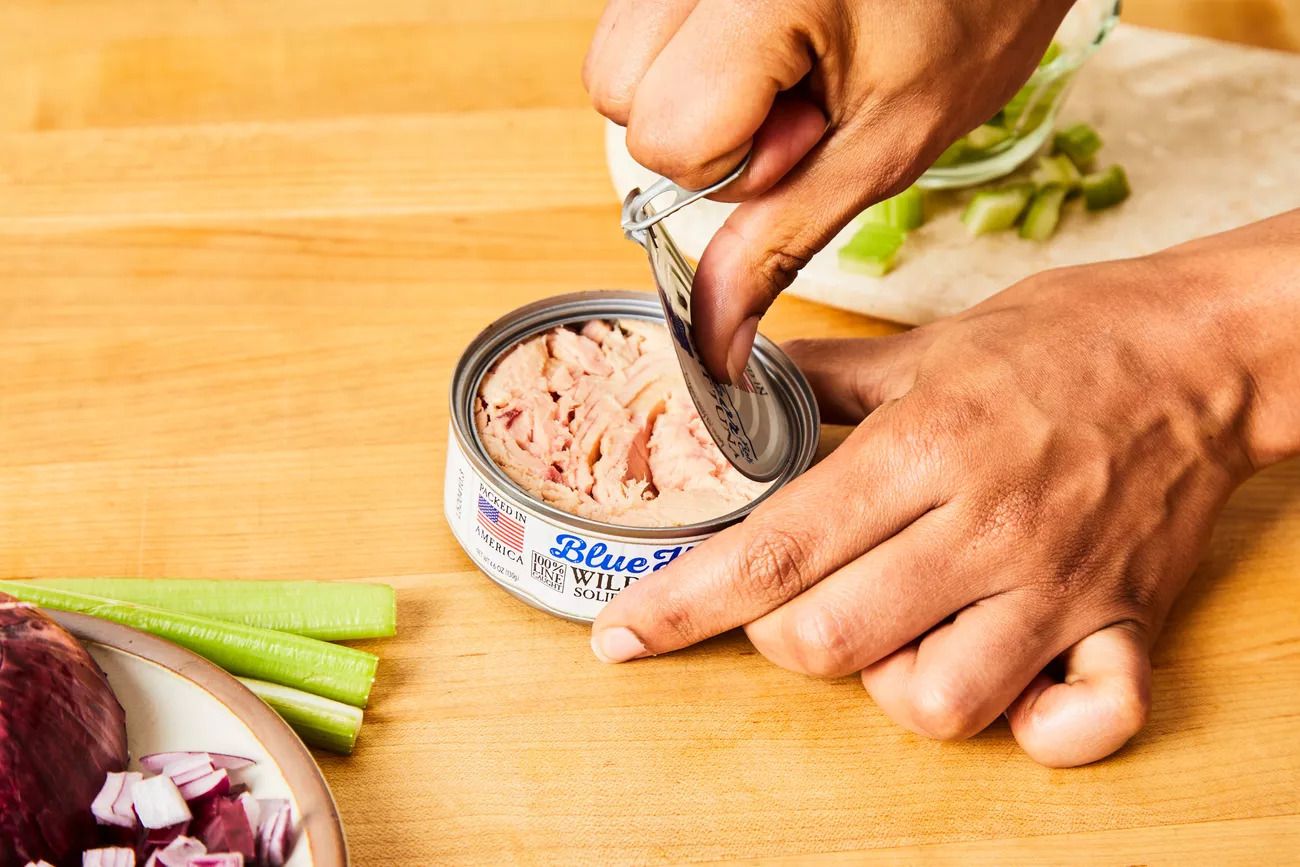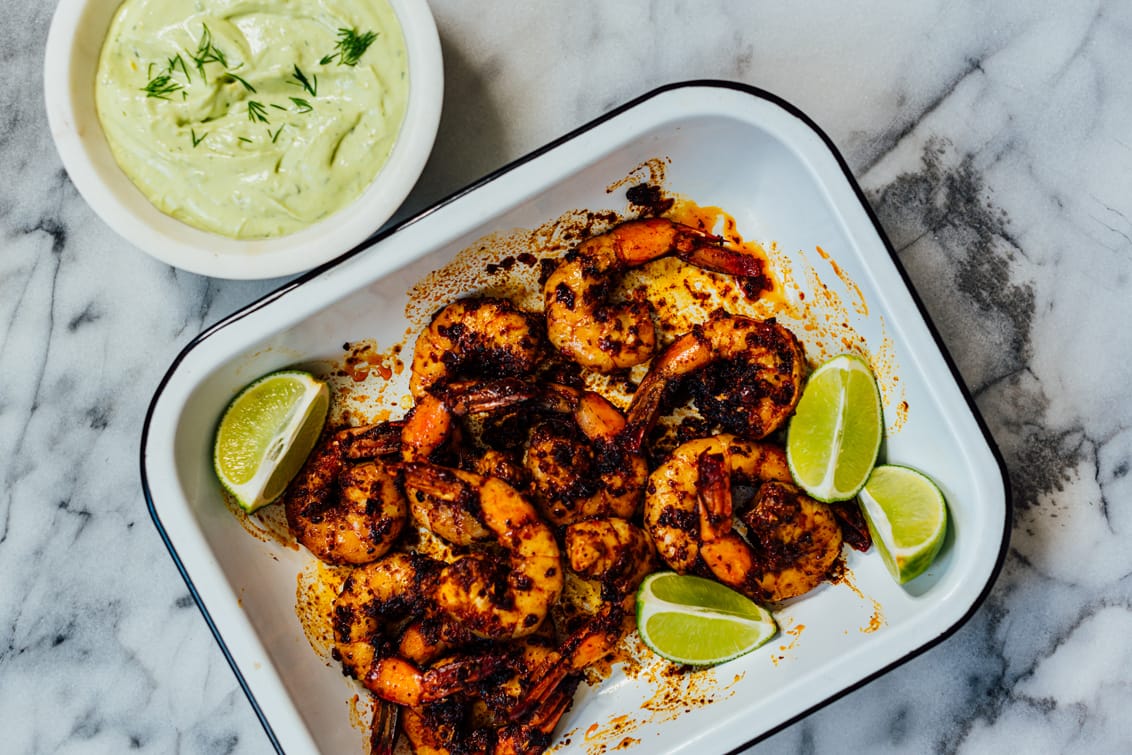Hey fitness nerds!
Thank you all {{active_subscriber_count}} of you!
Every fitness chart tells you to lift a certain weight at a certain age. But most of these standards come from competitive lifters and ignore real life circumstances.
You need benchmarks that actually reflect functional strength for healthy living.
Read 🔽 below!
💪
IN LESS THAN 10 MINUTES WE WILL COVER:
Weekly Insights:
Strength standards by age you can actually use
Article Explained Simple: Protein Distribution Across the Day and Why Breakfast Matters
3 Tips for Pantry Proteins for Nights You Did Not Plan Dinner
Harissa Shrimp and White Bean Skillet with Citrus Yogurt Recipe
Strength standards by age you can actually use

Most strength standards ignore what actually matters for health and function.
The internet overflows with charts comparing you to competitive powerlifters instead of providing realistic benchmarks for maintaining independence and preventing injury. These comparisons create unnecessary frustration.
Functional strength differs from competitive strength.
Your ability to perform daily activities without assistance matters far more than how much you can bench press. Carrying groceries, climbing stairs, getting up from the floor, and maintaining balance all require specific strength thresholds.
Research shows that strength levels below certain minimums predict loss of independence and increased mortality risk. These functional minimums provide better targets than arbitrary competitive standards.
Here are realistic strength standards by decade.
In your 20s and 30s, your focus should be building a strength reserve that lasts decades. Men should aim to deadlift 1.5 times body weight and women should target 1 times body weight.
For upper body pushing, men should bench press their body weight for 5 reps. Women should aim for 0.6 times body weight for 5 reps.
Lower body pushing means squatting 1.25 times body weight for men and 0.8 times for women for 5 clean reps. These numbers provide enough reserve to maintain function as you age.
During your 40s and 50s, maintaining strength becomes critical. Natural decline begins around age 40 but progresses slowly with proper training.
Men should maintain deadlifts at 1.25 times body weight and women at 0.8 times body weight. This prevents the rapid decline that leads to frailty in later decades.
Upper body standards shift to 0.8 times body weight for men and 0.5 times for women on bench press for 5 reps. Lower body squats should remain at 1 times body weight for men and 0.6 times for women.
Beyond age 60, preservation overtakes progression. Every pound of strength you maintain protects your independence and reduces fall risk.
Men should aim for deadlifts at 1 times body weight and women at 0.6 times body weight. These levels ensure you can lift moderately heavy objects safely.
Bench press targets drop to 0.6 times body weight for men and 0.4 times for women. Squats should stay at 0.8 times body weight for men and 0.5 times for women.
These standards assume regular training.
Lifting weights 3 times per week maintains these levels throughout your life. Without consistent training, expect to fall below these benchmarks within years.
The standards also assume you started training before the decade begins. If you start lifting at age 50, reaching these numbers takes 2 to 3 years of consistent work.
Bodyweight strength standards matter more as you age.
Being able to do 10 push ups, hold a plank for 60 seconds, and perform 10 bodyweight squats predicts independence better than any barbell movement.
For people over 60, getting up from the floor without using hands becomes the single best predictor of mortality risk. This requires significant leg and core strength.
Pull ups or chin ups reveal upper body pulling strength. Men should maintain 5 strict pull ups and women should aim for 1 strict pull up throughout middle age.
Grip strength provides the simplest standard.
Men should maintain 45 kilograms of grip strength measured with a hand dynamometer through their 40s and 50s. Women should maintain 27 kilograms.
After age 60, maintaining 40 kilograms for men and 25 kilograms for women predicts continued independence and reduced disability risk.
Grip strength correlates strongly with overall body strength and health outcomes. Testing it weekly provides immediate feedback on your training effectiveness.
What happens when you fall below these standards.
Strength below functional minimums increases injury risk during daily activities. Simple tasks like opening jars or carrying laundry become difficult.
Falls become more likely because your muscles cannot stabilize your joints quickly enough. Each fall increases fear of falling, which reduces activity and accelerates decline.
Loss of independence follows predictably. Activities requiring moderate strength become impossible without assistance. This dependence on others reduces quality of life dramatically.
How to reach or maintain these standards.
Progressive overload remains essential at every age. Add small amounts of weight or reps each week to force adaptation.
Compound movements provide the most efficient path to functional strength. Squats, deadlifts, presses, and rows develop multiple muscle groups simultaneously.
Frequency matters more than volume as you age. Three shorter sessions per week beat one long exhausting workout.
Adequate protein intake of 0.8 to 1 gram per pound of body weight supports strength development at any age. Without sufficient protein, training stimulus goes to waste.

Momentous Creatine Chews: Chewable creatine done the right way—no fillers, no fluff, intentionally minimal ingredients.
We know creatine is a daily essential. But while others chase trends, Momentous sets standards.
New Momentous Creatine Chews deliver 1g of pure Creapure® in each bite-sized tablet; nothing artificial, nothing unnecessary, just everything you need from chewable creatine.
Always NSF Certified.

Fitness and health enthusiasts - We have a lot of things in store for you!
Check out busybody.io - and join the waitlist for our brand-new AI health app.
Article of the Week
Article Explained Simple: Protein Distribution Across the Day and Why Breakfast Matters
Scientists studied how meal distribution of protein affects muscle protein synthesis throughout the day. They discovered a surprising connection to your circadian rhythm.
Protein intake at breakfast promotes muscle growth more effectively than protein at dinner. This effect depends on your muscle's internal clock, which regulates how tissues respond to nutrients.
Mice fed protein at the early active phase showed significantly greater muscle hypertrophy compared to protein consumed later. This pattern disappeared in mice without functioning circadian clocks.
The research extended to humans. People who consumed more dietary protein at breakfast demonstrated higher muscle function including better skeletal muscle index and grip strength.
Most people do the opposite. Typical protein consumption is lowest at breakfast and highest at dinner, often by 3 to 4 times.
Studies measuring 24 hour muscle protein synthesis found that evenly distributed protein across meals stimulated 25 percent more muscle building than skewed distribution.
When participants ate 30 grams of protein at breakfast versus only 10 grams, muscle protein synthesis increased by 30 percent after the breakfast meal.
The practical implication is clear. Front loading protein intake toward breakfast and lunch optimizes muscle maintenance and growth throughout your life.
Fascinating Fact:
Your muscles have their own circadian clocks that make them more responsive to protein and exercise during morning and early afternoon hours compared to evening.
We have a new 1 referral reward for all of you. This one has made my life 12 times easier and significantly improved my health. Best thing, it saves me $227 each month.
Make Trillions of Probiotics at Home
Get the #1 Probiotic Yogurt Maker in America.
Stop wasting money on expensive probiotics that don't work.
It's easy to make trillions of live probiotics to support healthy digestion, weight, and energy.
Enjoy your own creamy, rich homemade probiotic yogurt.
Not evaluated by the FDA. This product isn’t meant to diagnose, treat, or cure.
3 Tips for Pantry Proteins for Nights You Did Not Plan Dinner
These shelf stable proteins save you from ordering takeout when meal planning fails.

Canned Fish
Canned salmon, tuna, sardines, and mackerel provide 20 to 25 grams of protein per can.
These fish contain omega 3 fatty acids and require zero cooking. Mix with Greek yogurt and spices for instant protein salad.
Throw them into pasta, rice, or on top of salads for a complete meal in under 10 minutes.
The cans last for years in your pantry and cost 2 to 4 dollars each.
Canned beans
Black beans, chickpeas, kidney beans, and white beans deliver 12 to 15 grams of protein per can.
Rinse them to remove excess sodium, then add to literally anything. They work in soups, salads, grain bowls, and as side dishes.
Mash chickpeas with spices for instant high protein spread. Heat black beans with taco seasoning for quick burrito filling.
Canned beans cost under 1 dollar per can and provide excellent value per gram of protein.
Canned chicken
Pre cooked canned chicken provides 25 grams of protein per small can and needs no preparation.
The texture works better mixed into dishes rather than eaten alone. Add to pasta, rice bowls, quesadillas, or casseroles.
Season it heavily because canned chicken tastes bland by itself.
Buffalo sauce, barbecue sauce, or curry powder transform it.
Each can costs 2 to 3 dollars and stays fresh for years.
You’re invited to the world’s largest email marketing conference.
Become an email marketing guru at the GURU conference. It’s two days full of all things email marketing. Learn more about newsletters, deliverability, design trends, AI, and what NOT to do with email.
What you can expect:
Keynote Speakers: Nicole Kidman, Amy Porterfield & more!
The latest digital trends in email marketing & how to increase performance.
Networking opportunities - each day!
Dj’s, dance contests (judged by Lance Bass, yes for real), breaking world records & MORE!
Spots are limited. It’s VIRTUAL. It’s FREE. It’s time to become an email marketing GURU. Join 25,000+ marketers on November 6th & 7th. Don’t miss out!
YES! I want to register! (US attendees only!)
Harissa Shrimp and White Bean Skillet with Citrus Yogurt Recipe (makes 4 servings)
This North African inspired dish delivers bold flavor in one pan. The citrus yogurt balances the spicy harissa perfectly.
It cooks in 15 minutes start to finish and requires minimal cleanup.
This recipe was created in 2 minutes with the BusyBody App. Click the button for free access to the app.
Macros per Serving

Total Calories: 340 kcal
Protein: 38 g
Carbohydrates: 28 g
Sugars: 4 g
Fat: 10 g
The Ingredients
500g large shrimp, peeled and deveined
2 cans white beans (800g total), drained and rinsed
2 tablespoons harissa paste
2 tablespoons olive oil
1 large onion, diced
3 cloves garlic, minced
1 red bell pepper, diced
2 tablespoons tomato paste
250ml low sodium chicken broth
1 teaspoon cumin
1 teaspoon smoked paprika
Juice of 1 lemon
2 tablespoons fresh cilantro, chopped
Salt and pepper to taste
For the citrus yogurt:
150g Greek yogurt
Zest of 1 lemon
Juice of half a lemon
Pinch of salt
The Instructions
Mix the Greek yogurt with lemon zest, lemon juice, and salt. Set aside in the refrigerator while you cook.
Heat 1 tablespoon olive oil in a large skillet over medium high heat.
Season shrimp with salt and pepper.
Cook for 2 minutes per side until just pink. Remove and set aside.
Add remaining olive oil to the same skillet. Cook onion for 3 minutes until softened.
Add garlic, bell pepper, cumin, and smoked paprika. Cook for 2 minutes stirring frequently.
Stir in tomato paste and harissa. Cook for 1 minute to develop flavors.
Add white beans and chicken broth. Bring to a simmer and cook for 5 minutes.
Mash about one third of the beans with the back of a spoon to thicken the sauce.
Return shrimp to the pan along with lemon juice. Stir gently to combine.
Cook for 2 more minutes until everything is heated through.
Garnish with fresh cilantro and serve immediately with a dollop of citrus yogurt on top.
Seeking impartial news? Meet 1440.
Every day, 3.5 million readers turn to 1440 for their factual news. We sift through 100+ sources to bring you a complete summary of politics, global events, business, and culture, all in a brief 5-minute email. Enjoy an impartial news experience.
Make your dream of working online a reality and start a newsletter - join beehiiv for free and don’t pay any renewal fees until you grow your subscriber base >2500 subscribers.
I’ve personally tried plenty of other platforms, and Beehiiv is hands down the best and easiest to use.




